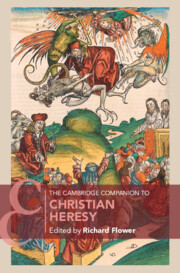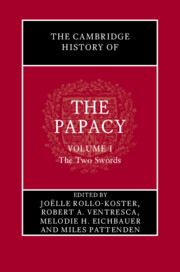Refine search
Actions for selected content:
167 results
2 - The Origins of the Statute of Uses
-
-
- Book:
- Law and Constitutional Change
- Published online:
- 26 September 2025
- Print publication:
- 16 October 2025, pp 27-43
-
- Chapter
-
- You have access
- Open access
- HTML
- Export citation
3 - Liturgies and the Reformation
- from Part I - Liturgy Throughout the Ages
-
-
- Book:
- The Cambridge Companion to Christian Liturgy
- Published online:
- 19 September 2025
- Print publication:
- 09 October 2025, pp 42-60
-
- Chapter
- Export citation
9 - Faith
- from Part II - The Merchants’ Selbstzeugnisse
-
- Book:
- Making Merchants
- Published online:
- 19 September 2025
- Print publication:
- 09 October 2025, pp 127-142
-
- Chapter
- Export citation

The Will in English Renaissance Drama
-
- Published online:
- 04 September 2025
- Print publication:
- 18 September 2025
‘[F]or hys ennemyes’: Katherine Parr’s Use of Romans and Doctrine of Christ’s Work in The Lamentation of a Sinner
-
- Journal:
- Journal of Anglican Studies , First View
- Published online by Cambridge University Press:
- 18 August 2025, pp. 1-9
-
- Article
-
- You have access
- Open access
- HTML
- Export citation
4 - Reformation and Confessional Pluralism
- from Part II - Notions and Practices of Equality
-
- Book:
- Democracy's Double Helix
- Published online:
- 09 September 2025
- Print publication:
- 14 August 2025, pp 129-140
-
- Chapter
- Export citation
2 - Religious Networks in the Reformation Era
-
- Book:
- Christianity at the Crossroads
- Published online:
- 19 May 2025
- Print publication:
- 31 July 2025, pp 45-75
-
- Chapter
- Export citation
17 - Wyclif, Lollards and Popular Heresy
- from Part II - Case Studies
-
-
- Book:
- The Cambridge Companion to Christian Heresy
- Published online:
- 17 July 2025
- Print publication:
- 31 July 2025, pp 345-362
-
- Chapter
- Export citation

The Cambridge Companion to Christian Heresy
-
- Published online:
- 17 July 2025
- Print publication:
- 31 July 2025
3 - (Counter-)Reformation in Unchristianised Europe
-
- Book:
- Silence of the Gods
- Published online:
- 19 June 2025
- Print publication:
- 19 June 2025, pp 163-220
-
- Chapter
- Export citation
3 - Monarchia Universalis: From Ordering Principle to Threat of Order
- from Part II - Introduction: From Universal Monarchy to Territorial Balance of Power
-
- Book:
- Representants and International Orders
- Published online:
- 15 May 2025
- Print publication:
- 08 May 2025, pp 69-112
-
- Chapter
- Export citation
23 - The Papacy and Printing, 1464–1633
- from Part IV - Education, Culture, Arts
-
-
- Book:
- The Cambridge History of the Papacy
- Published online:
- 28 February 2025
- Print publication:
- 20 March 2025, pp 656-680
-
- Chapter
- Export citation
General Introduction
-
- Book:
- The Cambridge History of the Papacy
- Published online:
- 28 February 2025
- Print publication:
- 20 March 2025, pp 1-32
-
- Chapter
- Export citation
General Introduction
-
- Book:
- The Cambridge History of the Papacy
- Published online:
- 28 February 2025
- Print publication:
- 20 March 2025, pp 1-32
-
- Chapter
- Export citation
General Introduction
-
- Book:
- The Cambridge History of the Papacy
- Published online:
- 28 February 2025
- Print publication:
- 20 March 2025, pp 1-32
-
- Chapter
- Export citation
17 - Papal Law in the English Church: Post-Reformation Anglican Jurisprudence
- from Part III - Canon Law
-
-
- Book:
- The Cambridge History of the Papacy
- Published online:
- 28 February 2025
- Print publication:
- 20 March 2025, pp 442-465
-
- Chapter
- Export citation
13 - The Reformation Popes
- from Part III - Reformations and Revolutions
-
-
- Book:
- The Cambridge History of the Papacy
- Published online:
- 28 February 2025
- Print publication:
- 20 March 2025, pp 343-365
-
- Chapter
- Export citation
Sex in Prussia: How Forbidden Marriage and Forced Migration Birthed the First Protestant Church, 1500–25
-
- Journal:
- Central European History / Volume 58 / Issue 1 / March 2025
- Published online by Cambridge University Press:
- 27 May 2025, pp. 67-86
- Print publication:
- March 2025
-
- Article
-
- You have access
- Open access
- HTML
- Export citation
Faith in Medicine: Christianity’s Legacy of Medical Charity: Presidential Address ASCH 2025 Chicago
-
- Journal:
- Church History / Volume 94 / Issue 1 / March 2025
- Published online by Cambridge University Press:
- 05 September 2025, pp. 61-70
- Print publication:
- March 2025
-
- Article
- Export citation

The Cambridge History of the Papacy
-
- Published online:
- 28 February 2025
- Print publication:
- 20 March 2025
